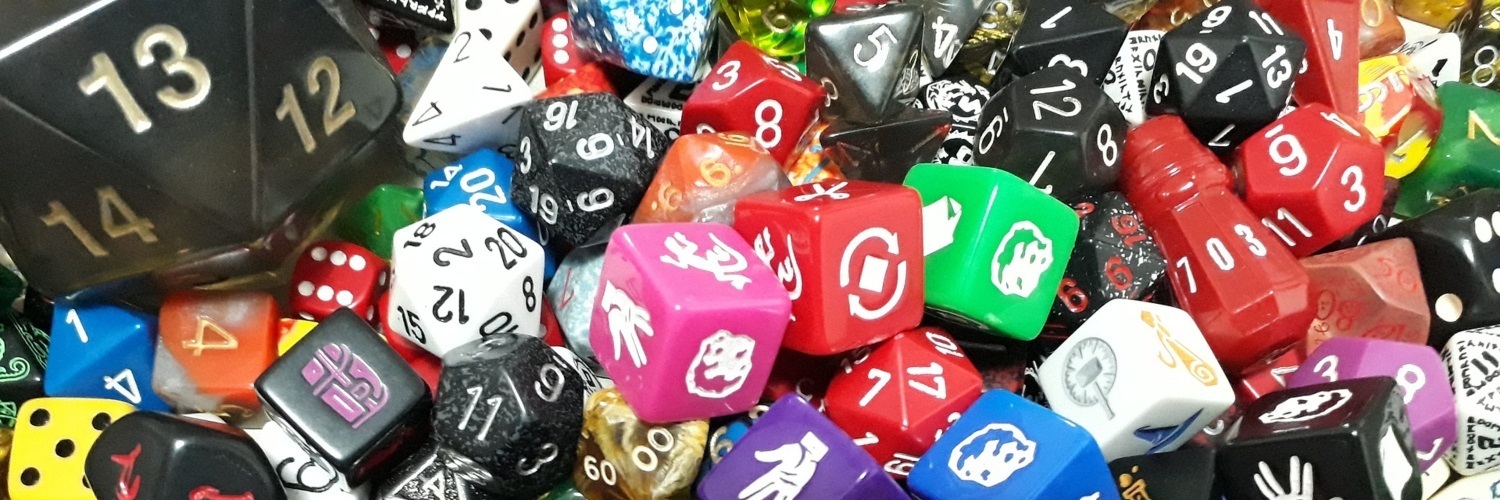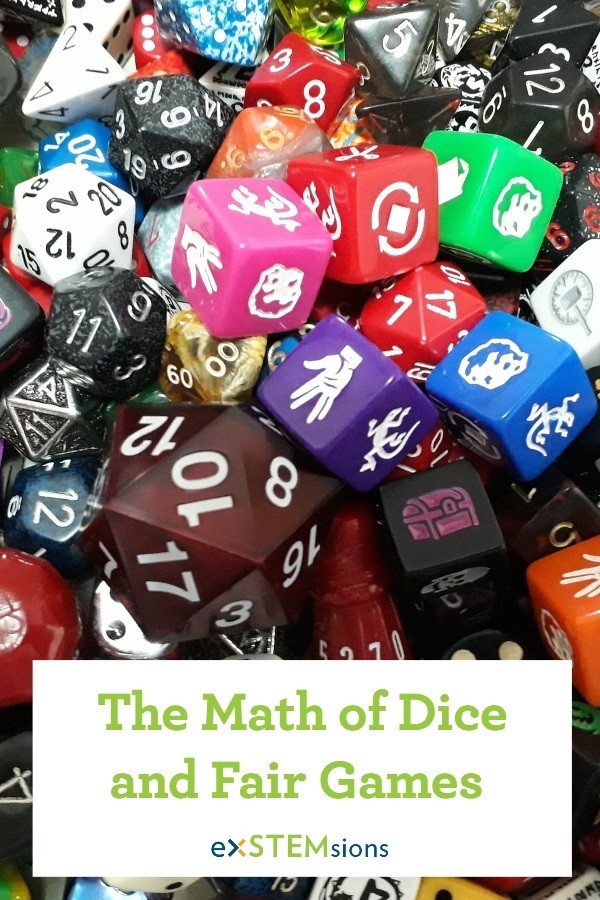The Math of Dice and Fair Games

Do you play games?
We do; we have a ton of board games tucked away in various cabinets around the house. Many of these games require dice of some sort. If you’re an avid game player, you’ve likely seen all kinds of dice shapes (have you seen the 100-sided die?). But there are only a few dice that seem to be fairly standard, and pop up in game after game after game. We happen to have an example of each one, collected from our various games:

All kinds of dice
The first two dice, a 4-sided die and a 6-sided die, are the subjects of one of our recent problems. (And in case you’re wondering just how to read that first die, you look down on it and read the bottom numbers; right now, it’s rolled as a 1.) The next three dice have 8, 12, and 20 sides, respectively. As it turns out, each of these dice is a well-known solid, and has a very mathematical name. From left to right, we have: a tetrahedron, a cube, an octahedron, a dodecahedron, and an icosahedron.
As we mentioned, these are not the only possible dice. So why do they keep appearing in so many games? Well, if you can get your hands on one of these dice, take a look at it. Use your knowledge of math, and powers of observation to your advantage. Suppose you’re looking at the cube. It’s very symmetrical, isn’t it? Each side, called a “face”, is the same size and shape as every other face. In particular, the shape of each face is very nice: it’s a square. And we can notice something about how these squares are arranged: each corner, or “vertex”, of the cube has three squares that meet right there. So, we’ve noticed three properties of the cube: every face is the same, every face is a nice shape, and three faces meet at every vertex. Can these properties be found on the other dice as well?
Check the first die, the tetrahedron. Every face is the same size and shape as every other; in particular, every face is a very nice triangle, an equilateral triangle! And once again, every vertex has three faces meeting there. Interesting…. By the way, these “nice” faces we’re seeing, they have a name too: they are regular polygons. A regular polygon has all sides equal, and all angles equal. An equilateral triangle is regular, since all of its sides are equal, and all angles measure 60 degrees. A square is also regular, since all sides are equal, and all angles measure 90 degrees.
What makes these dice special?
So, we’re noticing something cool about the first two dice: all faces are the same size and shape (fancy talk: congruent), all faces are regular polygons, and the same number of faces meet at each vertex. The number of faces at each vertex… must it always be 3? Check the third die, the octahedron. It has congruent equilateral triangles for faces, but four faces coming together at each vertex. And the fifth die also has congruent equilateral triangles for faces, but five faces coming together at each vertex! And the fourth die? All of its faces are congruent regular pentagons, with, once again, three faces meeting at each vertex.
Let’s recap. Each of our five dice satisfies the following properties:
- All faces are congruent to each other.
- Each face is a regular polygon.
- There is always the same number of faces meeting at each vertex.
Hmmm… these are special shapes indeed, so special, they have a name: Platonic solids. (They’re named after Plato, who wrote about them.) It’s because of these properties that these solids are nice to use as dice. Because they possess so much symmetry, every face is exactly the same as every other: not only in its size and shape, but also in its position relative to the other faces. That means that when a Platonic solid is rolled, any face is just as likely to come up as any other. That’s a good thing, because you definitely want your dice to play fair.

Time to investigate!
If you’re planning on making your own board game and need some dice, you might want to include some of these dice. And if you’re really excited about them, you might want to find more Platonic solids to use! Really, why limit yourself to these five? I mean, there are infinitely many regular polygons (right?)! With that many faces to choose from, there must be infinitely many Platonic solids too! Of course, we need to obey those three rules above, but that should be doable…. Right? Strangely… no. Those five Platonic solids up there? That’s it. There are no others. Unbelievable! The fact that there are only 5 Platonic solids certainly demands an explanation. And that explanation is a clever one, for sure; how could you possibly be 100% sure there are no other Platonic solids?? As you might guess, the explanation is pretty long, (it involves some big math and critical thinking), so we've decided not to include it in this post. We welcome you, though, to bust our your problem solving skills and explore this on your own. If you find something great, and you might, and want to discuss, we encourage you to share it with us! You can email [email protected], or tag us on Facebook, @exstemsionslearning. We can't wait to hear what you find!
Find this post interesting? Follow the blog using the link at the top of the page to get notified when new posts appear!
Does all of this talk about dice make you wonder what it might be like to try out dice with different sides and different numbers, and maybe play around with 'fairness'? We have just the thing for you! Download Dice for FREE today!
Want awesome tips and a mini-challenge, all designed to help you build vital problem-solving and critical thinking skills in your child? Click here to sign up for our monthly newsletter!



